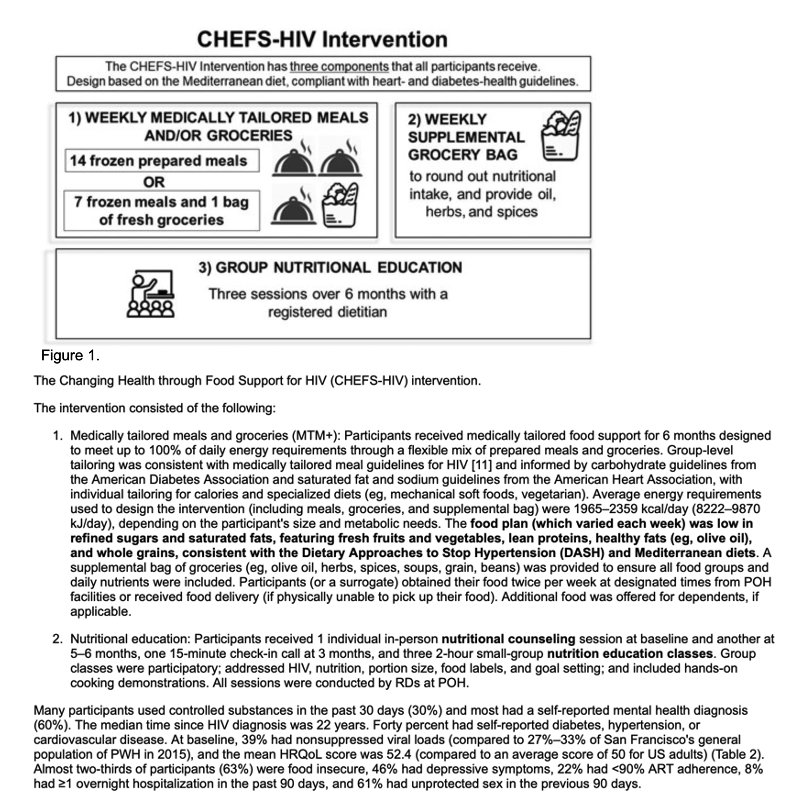| |
Food Is Medicine for Human Immunodeficiency Virus: Improved Health and Hospitalizations in the Changing Health Through Food Support (CHEFS-HIV) Pragmatic Randomized Trial
|
| |
| |
Download the PDF here
the federal Ryan White HIV/AIDS CARE Act provides HIV-specific funding for food and nutrition assistance via local nutrition safety-net programs. Traditional nutrition safety-net approaches focus on preventing hunger and reducing economic distress but sometimes have unintended consequences undermining health, such as providing foods high in salt or sugar [7].
Aligning food support with health and medical needs (an approach termed “food is medicine” [FIM]), particularly for populations with chronic illnesses, has the potential to address twin goals of improving food security and health [8]. The proposition is that FIM will improve health and reduce healthcare costs for people with chronic illnesses affected by social vulnerabilities, such as food insecurity, social isolation, or limited mobility [8].
Our pre-post pilot study of 72 individuals with HIV and/or diabetes found improvements in food security, depressive symptoms, and antiretroviral therapy (ART) adherence [10] after an FIM intervention.
We hypothesized that the intensive CHEFS-HIV intervention would improve viral load and health-related quality of life (HRQoL), as well as nutritional, mental health, behavioral, and healthcare utilization outcomes, compared to standard food support services.
RESULTS:
Medically tailored meals and groceries, combined with nutritional education, reduced hospitalizations, improved mental health and medication adherence, and decreased unprotected sex among PWH at high risk for food insecurity. These findings underscore the promise of MTM+ to improve multiple domains of health for PWH and reduce healthcare costs through lower healthcare utilization. With the current expansion and endorsement of FIM programs and policies at the US federal level as well as in many states [48, 49], our data can inform evidence-based design of medically supportive food programs locally and nationally. Larger studies are warranted to understand how different modalities of implementing food support programs impact HIV and non-HIV clinical outcomes.
Six-Month Outcomes
At 6-month follow-up, 168 participants (88%) remained in the study. Study retention was similar in both study arms (intervention, 89%; control, 87%). Baseline characteristics of participants lost to follow-up were similar to those of participants who completed the study, except for a lower monthly income.
The prevalence of nonsuppressed viral load decreased in both study arms over the 6-month study period, with no difference between arms (Table 2). There was no difference in HRQoL scores between the arms over 6 months.
Intervention arm participants had 77% lower odds of a more severe food insecurity category (odds ratio [OR], 0.23 [95% confidence interval {CI}, .087–.617]; P = .003) over 6 months, compared to the control arm, and 68% lower odds of a more severe depressive symptoms category (OR, 0.32 [95% CI, .125–.834]; P = .020). The intervention arm exhibited a greater decrease in fatty food consumption than the control arm (β = −.170, standard error [SE] = 0.085; P = .044), but there was no difference in fruit and vegetable consumption between arms (β = .062, SE = 0.079; P = .430) over 6 months.
Intervention arm participants had 82% lower odds of <90% ART adherence (OR, 0.18 [95% CI, .0389–.821]; P = .030) over 6 months, compared to the control arm. The intervention arm also had 95% lower odds of unprotected sex in the previous 90 days (OR, 0.05 [95% CI, .00385–.528]; P = .014) over 6 months.
The percentage of participants with overnight hospitalizations in the past 90 days decreased from 11% to 5% in the intervention arm over 6 months but increased from 6% to 11% in the control arm, translating to 89%lower odds of hospitalization (OR, 0.11 [95% CI, .0134–.960]; P = .046) in the intervention arm, compared to the control arm.
Intervention
The CHEFS-HIV intervention (Figure 1) was designed by POH's registered dietitians (RDs), POH leadership, and study investigators, incorporating lessons learned from the pilot study such as allowing a more flexible balance of meals versus groceries, based on participant preference. In addition, participants could reduce the amount of food received if they could not store or did not need it, as long as they received more food than their previous POH service level (“standard of care”).

|
|
| |
| |
|
|
|